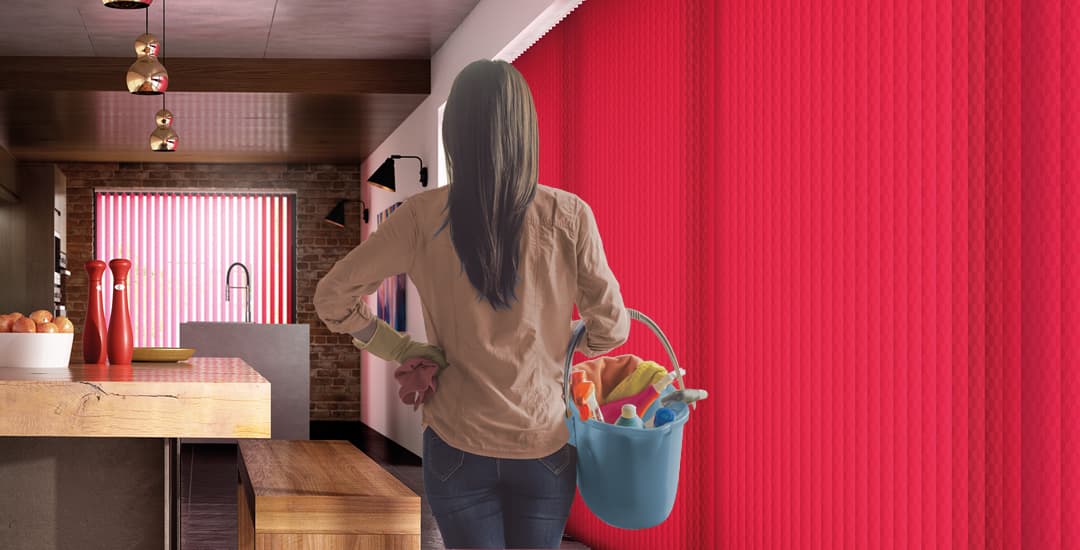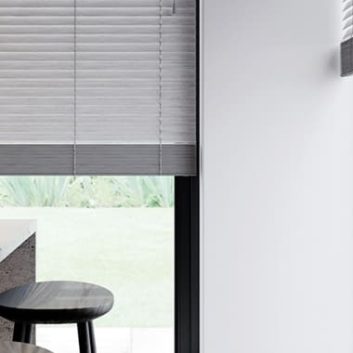
If you use vertical blinds in an environment that gets moist or humid (like a kitchen or bathroom) or on any window that tends to suffer from condensation and so, that causes the blind itself to get damp regularly, it might eventually begin to grow mould or mildew.
Something that many office workers found when they returned to in-house work after the final Covid lockdown ended is that their office vertical blinds had begun to grow mould or mildew in their absence, after several months of being left in an unventilated and potentially damp, chilly room while everyone had departed en masse to work from their dining room tables.
Vertical blinds are becoming an ever-more popular choice for homes too, particularly for wide windows, tall windows and patio doors, and so you might end up facing a similar problem at home if your blind is exposed to humidity or damp, or your window suffers from condensation.
Anyway, regardless of how it happened in the first place, how do you clean mould and mildew from vertical blinds? This blog post will outline the best way to get mould or mildew off vertical blinds, depending on what material they’re made of.
What are vertical blinds?
So you missed a deadline, your boss is mad, and suddenly it’s your job to “get that black spotty crap off the blinds while you’re at it.” Different types of blinds need different approaches to cleaning them without ruining them, so let’s first of all make sure we’re all singing from the same hymn sheet in terms of what vertical blinds actually are.
Simple version: They’re the only type of blind that hangs vertically. All good? Ok.
Vertical blinds are made of individual strips of fabric called “louvres,” which hang from top to bottom, they have weights at the base of each louvre, and they are strung together by a chain. Vertical blind louvres can be tilted to filter light, as well as opened and closed.
What are vertical blinds made of?
There are two different materials commonly used to construct vertical blinds. One of these is PVC and the other is polyester, the latter generally treated with a stiffening agent or starch.
These two fabrics have rather different traits and applications; for kitchens, bathrooms, or rooms otherwise prone to damp or humidity, PVC vertical blinds are the best choice. This is because they’re waterproof, can be wiped clean, and won’t get tide marks and stains from contact with water and general mank.
Polyester vertical blinds are better reserved for rooms that don’t get wet or humid, as lots of moisture in the air or in direct contact with the blind tends to not only stain it, but can also result in the breakdown of the stiffening agent used on it too, which is necessary to make them look good and hang correctly.
Are vertical blinds particularly prone to growing mould and mildew?
Vertical blinds do not have a particular propensity to grow mould and mildew, and they’re overall less likely to do so than either roller blinds or Roman blinds used in the same setting. This is because both roller and Roman blinds tend to be at least partially rolled up around their top tube even when fully closed, and so don’t get the chance to air out if they are exposed to moisture.
How prone a vertical blind is to growing mould or mildew in any setting depends on the fabric it is made of; PVC is less likely to grow mould or mildew as it doesn’t absorb water, and ironically, PVC vertical blinds are generally easier to remove mould or mildew from for the same reason.
However, if your vertical blind (regardless of what it is made of) is hung in a room that is regularly or constantly exposed to moisture or humidity – like a bathroom or kitchen, or even a room that suffers from damp and has poor ventilation, or on a window that tends to condensate a lot – it may start growing a fur coat or developing a skin condition over time.
How do you clean mould or mildew from vertical blinds?
There’s a couple of approaches to this depending on what the blind is made of. Some vertical blind louvres are machine washable (at a low temperature on a gentle cycle) and these tend to be PVC vertical blinds. But even if you know for sure that your blind is made of PVC, unless the care instructions or manufacturer’s directions specify that machine washing is ok, do not assume so!
If your vertical blind is good to go in the washing machine, this may be sufficient to remove mould and mildew from it entirely; but this is not always the case.
If your louvres come back out of the machine still sporting a new and unwanted design element or cannot safely be machine washed in the first place, here’s what to do:
- Take each of the blind’s louvres down from the headrail and lie them on a flat surface.
- Use a soft brush or the brush attachment of a vacuum cleaner to remove any dust and as much surface mould as possible. It is a really good idea to wear a face covering while doing this, to avoid inhaling spores.
- Make up a solution of distilled white vinegar, lemon juice, and water in a spray bottle. Spray this directly onto the areas that are mouldy or growing mildew.
- You will want to get the fabric damp rather than drenching it, but you do want the solution to penetrate the fabric if your blind is made of polyester, to ensure you get to all of the mould or mildew.
- Leave this to soak in for maybe half an hour, then wipe the louvres clean with a damp cloth.
- Pat the louvres as dry as you can manage with a towel, then allow them to fully air dry.
If you’re removing mould or mildew from polyester blinds, test your lemon juice/vinegar/water solution out on a small, unobtrusive area of one louvre first, to ensure that it does not discolour it.
If this does occur, you might find that your choices are limited to leaving the mould or mildew in place as a design feature, accepting the resultant discolouration that will come from proceeding with cleaning your blind, or realising that your blinds have reached the end of their natural lifespan and require replacement.
If you do decide to go with the latter, we just happen to have a significant number of vertical blinds for sale that you might like…





What is the ratio for cleaning with white vinegar, lemon juice and water please ?
Thank you for your question. The ratio we would recommend is ½ cup of distilled water, ½ cup of vinegar and 1 tsp lemon juice.